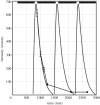On the attempts to measure water (and other volatiles) directly at the surface of a comet
- PMID: 28416724
- PMCID: PMC5394252
- DOI: 10.1098/rsta.2015.0385
On the attempts to measure water (and other volatiles) directly at the surface of a comet
Abstract
The Ptolemy instrument on the Philae lander (of the Rosetta space mission) was able to make measurements of the major volatiles, water, carbon monoxide and carbon dioxide, directly at the surface of comet 67P/Churyumov-Gerasimenko. We give some background to the mission and highlight those instruments that have already given insights into the notion of water in comets, and which will continue to do so as more results are either acquired or more fully interpreted. On the basis of our results, we show how comets may in fact be heterogeneous over their surface, and how surface measurements can be used in a quest to comprehend the daily cycles of processes that affect the evolution of comets.This article is part of the themed issue 'The origin, history and role of water in the evolution of the inner Solar System'.
Keywords: Rosetta; comets; space mission; volatiles; water.
© 2017 The Author(s).
Conflict of interest statement
The authors declare that there are no competing interests.
Figures




Similar articles
-
The Rosetta mission orbiter science overview: the comet phase.Philos Trans A Math Phys Eng Sci. 2017 Jul 13;375(2097):20160262. doi: 10.1098/rsta.2016.0262. Philos Trans A Math Phys Eng Sci. 2017. PMID: 28554981 Free PMC article. Review.
-
The 67P/Churyumov-Gerasimenko observation campaign in support of the Rosetta mission.Philos Trans A Math Phys Eng Sci. 2017 Jul 13;375(2097):20160249. doi: 10.1098/rsta.2016.0249. Philos Trans A Math Phys Eng Sci. 2017. PMID: 28554971 Free PMC article.
-
On the Origin and Evolution of the Material in 67P/Churyumov-Gerasimenko.Space Sci Rev. 2020;216(5):102. doi: 10.1007/s11214-020-00718-2. Epub 2020 Jul 30. Space Sci Rev. 2020. PMID: 32801398 Free PMC article. Review.
-
The Philae lander mission and science overview.Philos Trans A Math Phys Eng Sci. 2017 Jul 13;375(2097):20160248. doi: 10.1098/rsta.2016.0248. Philos Trans A Math Phys Eng Sci. 2017. PMID: 28554970 Free PMC article. Review.
-
Detection of argon in the coma of comet 67P/Churyumov-Gerasimenko.Sci Adv. 2015 Sep 25;1(8):e1500377. doi: 10.1126/sciadv.1500377. eCollection 2015 Sep. Sci Adv. 2015. PMID: 26601264 Free PMC article.
Cited by
-
The origin, history and role of water in the evolution of the inner Solar System.Philos Trans A Math Phys Eng Sci. 2017 May 28;375(2094):20170108. doi: 10.1098/rsta.2017.0108. Philos Trans A Math Phys Eng Sci. 2017. PMID: 28416731 Free PMC article. No abstract available.
References
-
- Whipple FJ. 1950. A comet model. I. The accretion of comet Encke. Astrophys. J. 111, 375–395. (10.1086/145272) - DOI
-
- Keller HU, et al. 1986. First Halley multicolour camera imaging results from Giotto. Nature 321, 320–326. (10.1038/321320a0) - DOI
-
- Greenberg JM. 1986. Predicting that Halley is dark. Nature 321, 385 (10.1038/321385a0) - DOI
Publication types
LinkOut - more resources
Full Text Sources
Other Literature Sources

